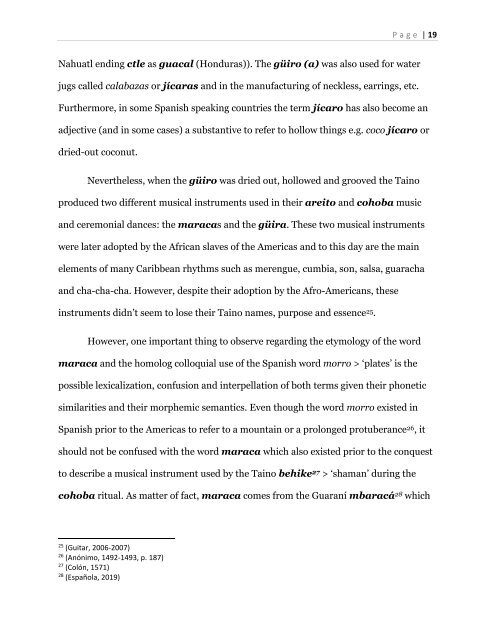Language of the Voiceless: Traces of Taino Language, Food, and Culture in the Americas From 1492 to the Present
by Leonardo Nin
by Leonardo Nin
You also want an ePaper? Increase the reach of your titles
YUMPU automatically turns print PDFs into web optimized ePapers that Google loves.
P a g e | 19<br />
Nahuatl end<strong>in</strong>g ctle as guacal (Honduras)). The güiro (a) was also used for water<br />
jugs called calabazas or jícaras <strong>and</strong> <strong>in</strong> <strong>the</strong> manufactur<strong>in</strong>g <strong>of</strong> neckless, earr<strong>in</strong>gs, etc.<br />
Fur<strong>the</strong>rmore, <strong>in</strong> some Spanish speak<strong>in</strong>g countries <strong>the</strong> term jícaro has also become an<br />
adjective (<strong>and</strong> <strong>in</strong> some cases) a substantive <strong>to</strong> refer <strong>to</strong> hollow th<strong>in</strong>gs e.g. coco jícaro or<br />
dried-out coconut.<br />
Never<strong>the</strong>less, when <strong>the</strong> güiro was dried out, hollowed <strong>and</strong> grooved <strong>the</strong> <strong>Ta<strong>in</strong>o</strong><br />
produced two different musical <strong>in</strong>struments used <strong>in</strong> <strong>the</strong>ir arei<strong>to</strong> <strong>and</strong> cohoba music<br />
<strong>and</strong> ceremonial dances: <strong>the</strong> maracas <strong>and</strong> <strong>the</strong> güira. These two musical <strong>in</strong>struments<br />
were later adopted by <strong>the</strong> African slaves <strong>of</strong> <strong>the</strong> <strong>Americas</strong> <strong>and</strong> <strong>to</strong> this day are <strong>the</strong> ma<strong>in</strong><br />
elements <strong>of</strong> many Caribbean rhythms such as merengue, cumbia, son, salsa, guaracha<br />
<strong>and</strong> cha-cha-cha. However, despite <strong>the</strong>ir adoption by <strong>the</strong> Afro-Americans, <strong>the</strong>se<br />
<strong>in</strong>struments didn’t seem <strong>to</strong> lose <strong>the</strong>ir <strong>Ta<strong>in</strong>o</strong> names, purpose <strong>and</strong> essence 25 .<br />
However, one important th<strong>in</strong>g <strong>to</strong> observe regard<strong>in</strong>g <strong>the</strong> etymology <strong>of</strong> <strong>the</strong> word<br />
maraca <strong>and</strong> <strong>the</strong> homolog colloquial use <strong>of</strong> <strong>the</strong> Spanish word morro > ‘plates’ is <strong>the</strong><br />
possible lexicalization, confusion <strong>and</strong> <strong>in</strong>terpellation <strong>of</strong> both terms given <strong>the</strong>ir phonetic<br />
similarities <strong>and</strong> <strong>the</strong>ir morphemic semantics. Even though <strong>the</strong> word morro existed <strong>in</strong><br />
Spanish prior <strong>to</strong> <strong>the</strong> <strong>Americas</strong> <strong>to</strong> refer <strong>to</strong> a mounta<strong>in</strong> or a prolonged protuberance 26 , it<br />
should not be confused with <strong>the</strong> word maraca which also existed prior <strong>to</strong> <strong>the</strong> conquest<br />
<strong>to</strong> describe a musical <strong>in</strong>strument used by <strong>the</strong> <strong>Ta<strong>in</strong>o</strong> behike 27 > ‘shaman’ dur<strong>in</strong>g <strong>the</strong><br />
cohoba ritual. As matter <strong>of</strong> fact, maraca comes from <strong>the</strong> Guaraní mbaracá 28 which<br />
25<br />
(Guitar, 2006-2007)<br />
26<br />
(Anónimo, <strong>1492</strong>-1493, p. 187)<br />
27<br />
(Colón, 1571)<br />
28<br />
(Española, 2019)


















